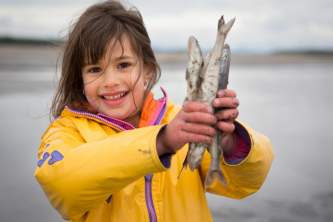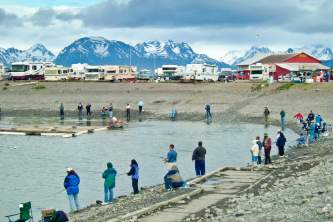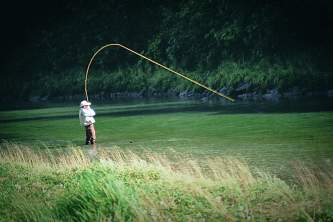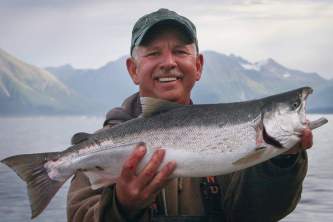Alaska Salmon Fishing Techniques
Need a salmon fishing primer (or refresher)? Here's the short take on the types of salmon you can pursue and the various methods that are used to target each species.
King Salmon
Silver Salmon
Red Salmon
King Salmon
Probably the most prized fish in Alaska, Kings are also one of the most difficult to catch. King salmon tend to swim in the deepest part of the river, which is typically right down the center. In places like the Kenai River, this makes it very difficult for shore anglers to catch them. However, for the patient and experimental shoreline angler, there are many opportunities to catch kings. Fish for kings a couple hours before and after a tidal change. Often, flies are used on low tides, and bait/lures are used on high tide. Before fishing for kings, make sure to get a king tag! This is the only species which requires an additional tag for legal fishing.
Flies: Use large, bright flies. Let these flow down the river at the same pace as the current (adjust weight as necessary). Kings are notoriously light biters, so if your fly stops, set the hook and hold on!
Spinning/Casting: Use large, bright lures (Vibrax size 5-6, Pixies, in pink, orange, chartreuse, blue, etc). For bait, you can use herring (near salt water) or salmon roe (all situations). This can be fished under a bobber, or from the bottom up. If you’re fishing from the bottom up, put your weight about 24” above the hook. Use any weight you’re comfortable with, but you want enough on there to either hold the bait in place under the water, or to bounce along at the same pace of the current. Use a “double mooch" (two hooks, one tied a couple inches above the other. You can buy them as premade rigs or set them up yourself. Put a golfball-sized piece of bait on the TOP hook, using the egg knot line to secure it down. Let the second hook dangle empty. Just cast this setup at your 10 o’clock position, and drift through your 2 o’clock position. Repeat.
Silver Salmon/Pink Salmon/Chum Salmon
The technique here is pretty much exactly the same as it was for King Salmon. The difference is where these fish swim. These salmon species tend to sit either in clear water or just on the edge of clear water. Clear water occurs when a small stream flows into a murky-colored stream. If there is no clear spots (or they are all clear), look for deep holes where the water slows down. This occurs around bends, behind big rocks, near trees, etc. Keep in mind that the reason fish will sit right outside of clear water is that they can be spooky. If there is a lot of bright sunlight, try using dark fly/lure patterns. These spooky fish will be less scared, and more inclined to bite.
Red Salmon
Red salmon (Sockeye) are one of Alaska’s most popular salmon. The best locations are typically the Kenai River, Russian River, and Kasilof River. These fish swim very close to the shore in medium swift currents. Don’t be the unaware fisherman who wades out 20ft only to block everyone else from catching the fish that are swimming behind you! Reds are not aggressive biters, so the common method of catching them is called “flossing”. The idea is that if you lay your line low in the water, the salmon will pick up the line in their mouth. At this point you “set the hook," which draws the hook into the corner of the fish’s mouth. This requires using the right amount of weight so that the line and hook move along the bottom of the river at the same pace of the current (This is important***). You can use any type of weight you feel comfortable with. Splitshot, slinkies, and sinklines are all common types. Leader lengths (the line between your weight and your fly) will vary based on water conditions. On the Russian River, where the stream is narrow and quick, typical leader lengths are between 18” and 24”. On the Kenai River, where the water is deep and wide, leader length is more often between 3’ and 5’. Adjust the leader length when needed. The goal is to ensure that the line and fly lay flat along the bottom. The standard fly to use is called the Russian River Fly (~.35 cents), but more effective alternatives are the #4 sockeye special and polar shrimp. These are more effective because they have a shorter shank. In the lower/middle Kenai River you can use larger hooks (a popular option is the 2/0 Octopus hook). You can use any sort of fly, as long as you can visibly see it in the water (this helps target fish and drift speed of the fly) and is legal (see the current regulations) - this usually means smaller than size 2 or 4).
The technique is fairly simple, and if you follow it, you have a great chance to land lots of fish. First, determine where you want to fish. Pull out enough line that you can “flip” your fly out about 15-20 ft (adjust this based on where fish are). Flip your line as far as it will go to your “10 o’clock position”, which should be past and upstream of your fish. Keeping your line taught, drift the line through the water at the same pace of the current until your line points to your “2 o’clock position”. Repeat. Remember, adjust your weight if your line is moving too quickly or slowly. This will be the difference between catching and not catching fish.




